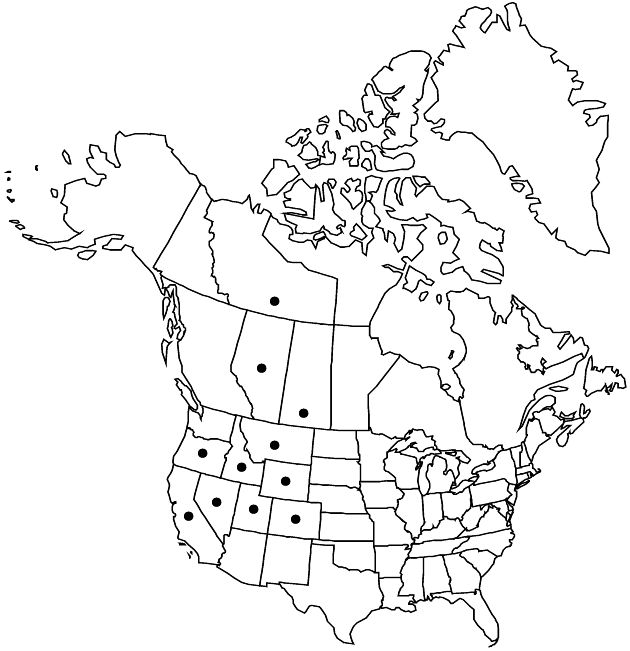Difference between revisions of "Pyrrocoma uniflora"
Erythea 2: 60. 1894.
FNA>Volume Importer |
RevisionBot (talk | contribs) m (Bot: Adding category Revised Since Print) |
||
| (8 intermediate revisions by 3 users not shown) | |||
| Line 8: | Line 8: | ||
}} | }} | ||
|common_names=Plantain goldenweed | |common_names=Plantain goldenweed | ||
| − | |basionyms={{Treatment/ID/ | + | |special_status={{Treatment/ID/Special_status |
| + | |code=E | ||
| + | |label=Endemic | ||
| + | }} | ||
| + | |basionyms={{Treatment/ID/Basionym | ||
|name=Donia uniflora | |name=Donia uniflora | ||
|authority=Hooker | |authority=Hooker | ||
| + | |rank=species | ||
| + | |publication_title=Fl. Bor.-Amer. | ||
| + | |publication_place=2: 25, plate 124. 1834 | ||
}} | }} | ||
|synonyms={{Treatment/ID/Synonym | |synonyms={{Treatment/ID/Synonym | ||
|name=Haplopappus uniflorus | |name=Haplopappus uniflorus | ||
|authority=(Hooker) Torrey & A. Gray | |authority=(Hooker) Torrey & A. Gray | ||
| + | |rank=species | ||
}} | }} | ||
|hierarchy=Asteraceae;Asteraceae tribe Astereae;Pyrrocoma;Pyrrocoma uniflora | |hierarchy=Asteraceae;Asteraceae tribe Astereae;Pyrrocoma;Pyrrocoma uniflora | ||
| Line 26: | Line 34: | ||
-->{{Treatment/Body | -->{{Treatment/Body | ||
| − | |distribution= | + | |distribution=Alta.;N.W.T.;Sask.;Calif.;Colo.;Idaho;Mont.;Nev.;Oreg.;Utah;Wyo. |
|discussion=<p>Varieties 2 (2 in the flora).</p><!-- | |discussion=<p>Varieties 2 (2 in the flora).</p><!-- | ||
| − | --><p>Pyrrocoma uniflora is recognized by its somewhat reduced habit, tomentose leaves and phyllaries, heads borne singly or in small racemes, and sericeous cypselae. It is probably most closely related to P. racemosa.</p> | + | --><p><i>Pyrrocoma uniflora</i> is recognized by its somewhat reduced habit, tomentose leaves and phyllaries, heads borne singly or in small racemes, and sericeous cypselae. It is probably most closely related to <i>P. racemosa</i>.</p> |
|tables= | |tables= | ||
|references= | |references= | ||
| Line 51: | Line 59: | ||
-->{{#Taxon: | -->{{#Taxon: | ||
name=Pyrrocoma uniflora | name=Pyrrocoma uniflora | ||
| − | |||
|authority=(Hooker) Greene | |authority=(Hooker) Greene | ||
|rank=species | |rank=species | ||
| Line 58: | Line 65: | ||
|basionyms=Donia uniflora | |basionyms=Donia uniflora | ||
|family=Asteraceae | |family=Asteraceae | ||
| − | |distribution= | + | |distribution=Alta.;N.W.T.;Sask.;Calif.;Colo.;Idaho;Mont.;Nev.;Oreg.;Utah;Wyo. |
|reference=None | |reference=None | ||
|publication title=Erythea | |publication title=Erythea | ||
|publication year=1894 | |publication year=1894 | ||
| − | |special status= | + | |special status=Endemic |
| − | |source xml=https:// | + | |source xml=https://bitbucket.org/aafc-mbb/fna-data-curation/src/2e0870ddd59836b60bcf96646a41e87ea5a5943a/coarse_grained_fna_xml/V19-20-21/V20_977.xml |
|tribe=Asteraceae tribe Astereae | |tribe=Asteraceae tribe Astereae | ||
|genus=Pyrrocoma | |genus=Pyrrocoma | ||
| Line 69: | Line 76: | ||
}}<!-- | }}<!-- | ||
| − | -->[[Category:Treatment]][[Category:Pyrrocoma]] | + | --> |
| + | |||
| + | [[Category:Treatment]] | ||
| + | [[Category:Pyrrocoma]] | ||
| + | [[Category:Revised Since Print]] | ||
Latest revision as of 19:24, 6 November 2020
Plants 7–40 cm. Stems 1–7, curved-ascending to decumbent, red-tinged, sparsely leafy to almost naked, glabrate to lanate or tomentulose, eglandular. Leaves: basal petiolate, blades linear to oblanceolate or elliptic, 40–150 × 3–20 mm, margins usually sharply dentate to laciniate, rarely entire; cauline sessile, few, blades lanceolate, 20–50 × 2–6 mm, bases cordate, clasping; faces glabrous, sparsely to densely shaggy-tomentose or lanate, eglandular. Heads usually borne singly, sometimes 2–4 in racemiform arrays. Peduncles 2–12 cm. Involucres hemispheric, 6–13 × 10–20 mm. Phyllaries in 2 series, appresssed or loose, linear-lanceolate, 6–11 mm, subequal or unequal (sometimes outer ± shorter and green throughout), margins ciliate, faces usually villous to lanate, rarely glabrous. Ray florets 18–50; corollas 7–11 mm. Disc florets 35–60; corollas 5–8 mm. Cypselae subcylindric, 2–4 mm, obscurely nerved and angled, faces sericeous; pappi tawny, 5–7 mm.
Distribution

Alta., N.W.T., Sask., Calif., Colo., Idaho, Mont., Nev., Oreg., Utah, Wyo.
Discussion
Varieties 2 (2 in the flora).
Pyrrocoma uniflora is recognized by its somewhat reduced habit, tomentose leaves and phyllaries, heads borne singly or in small racemes, and sericeous cypselae. It is probably most closely related to P. racemosa.
Selected References
None.
Key
| 1 | Stems and leaves tufted-tomentose; involucres 10–13 mm; phyllaries loosely appressed, unequal | Pyrrocoma uniflora var. gossypina |
| 1 | Stems and leaves tomentose to glabrate or glabrous; involucres 6–9 mm; phyllaries appressed, subequal | Pyrrocoma uniflora var. uniflora |